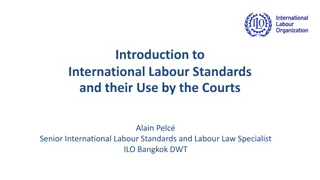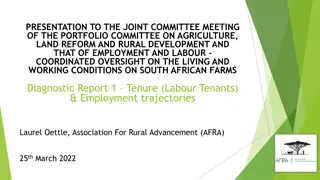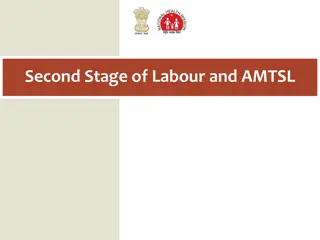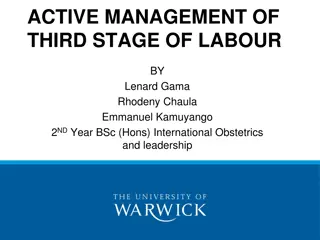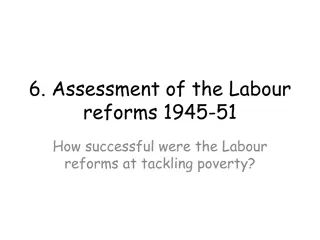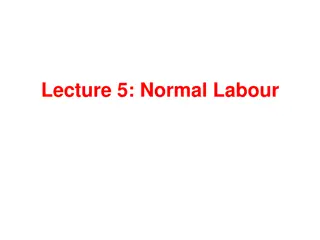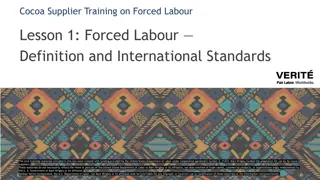Overview of Labour Laws in Department LP&IR
The presentation to the Portfolio Committee covers major labour laws such as the Labour Relations Act, Basic Conditions of Employment Act, National Minimum Wage Act, Employment Equity Act, and more. It details the objectives, enactment dates, and impact of key legislation in regulating employment relationships and facilitating collective bargaining. The overview emphasizes the importance of these laws in promoting fair labour practices, establishing rights for employers and employees, and addressing workplace disputes effectively.
Download Presentation

Please find below an Image/Link to download the presentation.
The content on the website is provided AS IS for your information and personal use only. It may not be sold, licensed, or shared on other websites without obtaining consent from the author. Download presentation by click this link. If you encounter any issues during the download, it is possible that the publisher has removed the file from their server.
E N D
Presentation Transcript
PRESENTATION TO PORTFOLIO COMMITTEE LABOUR LAWS OF THE DEPARTMENT LP&IR 05-02-2020
Table of content SLIDE NO. Labour Relations Act of 1995 (Act 66) (LRA ) 3-4 Basic Conditions of Employment Act 75 of 1997 (BCEA) 5-6 National Minimum Wage Act of 2018 (NMWA) 7 Employment Equity Act 55 of 1998 (EEA) 8 Employment Services Act of 2014 (ESA) 9 Unemployment Insurance Act (UIA) & Unemployment Insurance Contributions Act UICA) 10 Occupational Health and Safety Act 85 of 1993 (OHS) 11 Compensation For Occupational Injuries And Diseases Act, Of 1993 (COIDA) 12 3 August 2024 PRESENTATION TO PC 2
Overview of the LRA The Labour Relations Act (LRA) of 1995 (Act 66) was promulgated on 11 November 1996. The LRA was a by-product of NEDLAC social dialogue by organised labour, organised business and government. The objective of the LRA: to give effect to and regulate the rights endorsed by section 23 of the Constitution of the Republic of South Africa, 1996 to give effect to the country's obligations to the International Labour Organisation. to provide a framework in which employers, employees and their respective unions and organisations can engage in collective bargaining and formulate industrial policy. to promote orderly collective bargaining. - - - - 3 August 2024 PRESENTATION TO PC 3
Overview of the LRA To deal with adversarial labour market LRA introduced institutions like bargaining councils, the Commission for Conciliation, Mediation and Arbitration (CCMA) and the Labour Court. It established and entrenched the right to freedom of association which the right to form or belong to a trade union or employers organisation; and/or form or belong to employers' or trade union federation and enhanced organisational rights for trade unions LRA gave systematic similarities to bargaining councils: a basic shared architecture, same core functions and common objectives. It is a voluntary system made up of employers and trade unions. It democratised the workplace by creating an environment where employers and trade unions can collectively bargain about their employment conditions and wages that are appropriate to their sectors as well as dealing with their labour disputes effectively by promoting centralised collective bargaining. LRA codified dismissal procedures LRA introduced the Labour Court replaced the old ineffective Industrial Court. 3 August 2024 PRESENTATION TO PC 4
Overview of the BCEA The Basic Conditions of Employment Act (BCEA) 75 of 1997 (BCEA) was promulgated on 1 December 1998 and repealed the 1983 Act. It was a product of NEDLAC social dialogue by Government, Organised Labour and Organised business The purpose of the Basic Conditions of Employment Act: to give effect to the right to fair labour practices, as referred to in Section 23 (1) of the Constitution, to establish and providing for the regulation of basic conditions of employment, to regulate the variation of basic conditions of employment, to give effect to the obligations incurred by the Republic as a member of the International Labour Organisation. The Act positively impacted on the conditions of employment of some six million workers in its inception. It is aimed at improving the working conditions of unorganized and vulnerable workers. - - - - 3 August 2024 PRESENTATION TO PC 5
Overview of the BCEA - It specifically addressed the following problems: inadequate protection for vulnerable workers such as part-time, farm and domestic workers; poverty in employment regulation and prohibition of child labour; excessively long working hours, especially in areas such as transport and security; and gender discrimination, especially in relation to maternity leave. It sets minimum floor conditions of employment while also enabling conditions to be varied through collective bargaining, sectoral determinations, individual contracts of employment and through determinations made by the Minister of Labour. In order to accommodate the needs of different sectors of the economy who might be impacted negatively by some conditions, the following sectoral determinations prescribing minimum conditions applicable in the vulnerable sectors: Contracting Cleaning; Private Security, Domestic Work sector; Wholesale and Retail; Farm Worker sector; Forestry sector; Hospitality sector; Taxi sector; and Children in Performing Arts including sectoral determinations to protect learner in learnerships and worker in the expanded public works programme 5 291 165 employees. PRESENTATION TO PC 3 August 2024 - 6
Overview of the NMWA The Government introduced the National Minimum Wage Act of 2018. The objective of the Act is to improve low wages, protecting workers from unreasonably low wages, preserve the value of the NMW, promote collective bargaining and support economic policy. The Act is the product of consensus organised labour, organised business s, organised community and Government. It sets the NMW wage as floor right and no employee should enter the labour market below the floor right. It is expected to contribute to the reduction of wage industrial actions and further advance the Government policy intention of fighting poverty, unemployment and inequality. The Government has introduced the National Minimum Wage Commission which will annually review the national minimum wage level so as to respond to the developments in the labour market and improve the standard of life for our people. The NMW will cover and benefit more than 6 million workers. 3 August 2024 PRESENTATION TO PC 7
Overview of the EEA The Employment Equity Act 55 of 1998 (EEA) was passed by Parliament on 19 October 1998 The purpose of the Act: Promote equal opportunity and fair treatment in employment through the elimination of unfair discrimination; and implement affirmative action measures to redress the disadvantages in employment experienced by designated groups, in order to ensure their equitable representation in all occupational levels in the workforce. The Act promote equal pay for work of equal value. Commission for Employment Equity (CEE) established by EEA. Mandate of the CEE is to advise the Minister on: Codes of good practice; regulations; and policy and any other matter concerning the Act; Make awards recognising achievements of employers; Conduct research; and submit annual EE reports to the Minister on status of EE in the labour market. Codes of Good Practice on: HIV and AIDS in the World of Work and its Technical Assistance Guidelines (TAGs); Employment of Persons with Disabilities and its TAGs; Integration of EE into HR Policies, Practices & Procedures; Handling of Sexual Harassment Cases in the Workplace; Equal Pay for Work of Equal Value; and Preparation and implementation of EE Plans. 3 August 2024 PRESENTATION TO PC 8
Overview of the ESA The Employment Services Act of 2014 came into operation as from 9 August 2015. The Act was a by-product of NEDLAC Social dialogue. It purpose of the provide for schemes to assist employees in distressed companies to retain employment; to facilitate the employment of foreign nationals in a manner that is consistent with the objects of the Act and the Immigration Act, 2002; to provide for the registration and regulation of private employment agencies; to provide for the establishment of the Employment Services Board; to provide for the establishment of Productivity South Africa; to provide for the establishment of Supported Employment Enterprises; to provide for transitional provisions and to provide for matters connected therewith. It requires the department of labour to provide a number of public employment services including matching and placing work seekers with available work opportunities. It prescribes that each private employment agency must be registered. 3 August 2024 PRESENTATION TO PC 9
Overview of the UIA & UICA There are two Acts which apply and regulate the payment of unemployment insurance contributions, namely the Unemployment Insurance Act (UIA) and the Unemployment Insurance Contributions Act (UICA). The main objectives of these Acts are to establish the Unemployment Insurance Fund (UIF), to collect unemployment levies and to pay out claims to unemployed persons in the event of unemployment. These Acts apply to all employers and employees, except an employee who has been employed by that employer for less than 24 hours a month and his or her employer; employees under a learnership contract of employment in terms of the Skills Development Act 97 of 1998 and their employers; employees in the national and provincial spheres of government who are officers or employees as defined in the Public Service Act and their employers; and an employee and his or her employer when that employee is in the Republic for the purpose of carrying out a contract of service, apprenticeship or learnership if, on the termination of the contract, the employer is required by law, by the contract of service, apprenticeship or learnership or by any other agreement or undertaking to repatriate that person, or if that person is required to leave the Republic. 3 August 2024 PRESENTATION TO PC 10
Overview of the OHSA The Occupational Health and Safety Act 85 of 1993 is the law that seeks to protect the well-being of workers. The main aim is to ensure the health and safety of employees at work and also aims to protect people other than those employees at a workplace from hazards arising out of or in connection with the activities from the employees at the workplace. The Occupational Health and Safety Act is a pro-active attempt by the government to prevent and avoid work-related injuries and illnesses. The Act governs the health and safety for the diverse industry of South Africa. It regulates and controls health and safety in all organisations, from a normal office environment to more hazardous environments like industrial plants and construction sites. 3 August 2024 PRESENTATION TO PC 11
Overview of the COIDA The Compensation For Occupational Injuries And Diseases Act, Of 1993 The Compensation for Occupational Injuries and Diseases Act, No 130 of 1993 (COIDA) provides for compensation for disablement caused by occupational injuries or diseases sustained or contracted by employees in the course of their employment, or for death resulting from such injuries or diseases. Employers are required to submit a Return of Earnings form (W.As.8) on an annual basis. 3 August 2024 PRESENTATION TO PC 12
Thank You 3 August 2024 PRESENTATION TO PC 13





